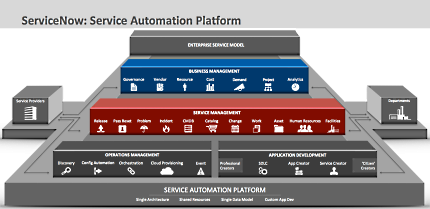ServiceNow was founded in 2003 and is recognized as one of the most exciting global cloud-based enterprise solutions companies.
The company is known for its service desk and IT management tools. Today, it is expanding its business in the areas of customer service, human resources and security.
In 2015, ServiceNow made a billion. The company’s goal is to achieve $4 billion in revenue by 2020. By then, half of the company’s revenue is expected to come from new services. For a brief historical reference of ServiceNow, please see here.
According to the concept adopted by ServiceNow, ITIL (Information Technology Infrastructure Library) method can be used to achieve continuous improvement of various functions of the enterprise. As you know, ITIL is a collection of IT service management best practices aimed at aligning IT with business.
ServiceNow has more than 300 customers implemented the new HR service and launched the security service in February 2016.

The company’s CEO Frank Slootman pointed out in his keynote speech at the company’s partner meeting that the demand for new ServiceNow services is already high and growing rapidly in industries such as software, telecommunications, finance, healthcare, and government agencies..
Interestingly, Sluotman said, because of the overall service management approach including security incident resolution and change management, today’s customers prefer service to CRM products. This only confirms the reduction of “pure” developers of internal CRM solutions, a situation that has been observed for several years. A few years ago, a similar thing happened at BI. Both now adopt a form of service that is simply suitable for cloud-based enterprise platforms.

In an interview with the CIO, ServiceNow’s Chief Content Officer (CCO) Dave Wright detailed how the company’s platform and public data sources can simplify and automate most corporate workflows and help organizations. Understand the true cost and inefficiency of its current business activities.
For domestic companies, it seems very interesting to be familiar with ServiceNow’s working principles and solutions. The following is the most interesting excerpt from this interview, without the quotes.
Where is ServiceNow located today, and what services do you provide for enterprises?
Recently, we have found that IT services are rapidly penetrating all corners of the company, enabling employees to complete their work easier and cheaper. Three main areas can be distinguished here. The first is service management tools, the second is what we call “IT stack ERP”, and the third is the platform itself and its scalability.
We look at everything from a service perspective. For a long time, everyone has said that IT is out of touch with business, but in fact the situation has not changed. In our solution, through the IT services collected in the CMDB (Configuration Management Database), you can control costs, reduce risks and always fully comply with regulations.
What does ServiceNow think IT leaders really need to know today?
We believe that the most important thing for him is to become a champion of a single and unique enterprise IT platform. If we acquire another company, the first thing we do is to rewrite their product so that it can be seamlessly integrated into our platform.

This is what the ServiceNow Service Automation Platform looks like today (you can click on the image to enlarge it)
This ensures that customers will never be incompatible with many second-hand IT products, nor will they encounter integration problems. Compared with developers working in our market segments, this approach is the biggest difference.
In the past year, earning $1 billion in revenue was a real feat for cloud companies. What is driving this huge growth?
Today, there are many gaps and contradictions in enterprise IT. One of the main gaps is the difference between the consumer experience and the employee’s workplace experience. In the company, the generations (people and IT development) are changing-therefore, the perspective has also changed. Our customers want to find the best way to do their job.
For example, in the past, when people saw a gap between their IT systems anywhere, they usually filled it with email. E-mail is everywhere, and people try to use it to run and organize business. But this is by no means designed for this.
We provide people with a single service catalog of IT and non-IT, let people use services, and then track and manage them. This is where we see revenue sources in the company’s infrastructure.
Who does ServiceNow consider as its main competitors?
I think we have many competitors in many fields. If we talk about ITSM (IT Service Management), then they are traditional participants in the ITSM field-BMC, HP, CA, etc. In the field of platforms, we met companies such as Salesforce.
For our part, we are trying to persuade people to implement enterprise service management solutions. And, usually, they don’t have and never have such a system.
How is your sales process organized? Do you have to sell your solutions department by department, or do you prefer it when customers have a complete understanding of the service management platform?
In some cases, CIOs are actually implementing departmental solutions. For me, CIO is always passive or active.
Responsive-those who receive some information and say-“do this to us and manage our services”. The prevention staff came to us and said, “We have a problem. Can you solve it in the best way?
They are people who use the concept of enterprise integration service management to operate. Interestingly, in the past two years, companies have seen roles specifically designed for this type of work. Gartner estimates that by 2018, such roles will appear in at least a quarter of large and medium-sized companies.
At the same time, we sometimes work with technical directors, and sometimes directly with business directors or dedicated service managers.
You name human resources, finance, and marketing as the main consumers of your services. Where is the progress faster?
These departments usually collaborate with each other, and our platform effectively provides them with a single environment where they can collaborate with data. Therefore, it is almost impossible to choose either direction.
What can you say about safe operation?
Based on our experience working with a large number of customers, we found that they want a system that enables them to respond appropriately to any security threats. All companies have always had many surveillance systems to detect intrusions. But when you find it, how does the parsing process actually proceed?
We provide dedicated products to help companies operate processes that comply with NIST rather than ITIL. Using it, they can conduct a complete review process when a security violation is detected, and take wise measures to correct the situation. In other words, implement preventive rather than passive safety management.
How does ServiceNow implement relevant analysis in its solutions?
Many companies implement analysis based on the older principles of ETL (extract, transform, load), that is, download data first and then analyze. We perform real-time analysis. We can understand what is currently happening in the system, and we have predictive tools. We rewrote a lot of analysis and built it into the platform.
What do customers expect from ServiceNow in the coming year?
We will take certain steps to increase the functionality of the platform. Enterprises will not only be able to manage public and hybrid clouds, but also implement technologies such as containerization and microservices.
They will also get enhanced features for mobile systems. In particular, we are working on services related to geographic location and biometric identification.
We also began to consider integrating video messaging into customer support. Generally speaking, the number of applications on our platform will increase in all directions in which services are provided.

Everything about modern cloud technology!
Don’t miss the next presentation of the Google Cloud Next ’20 OnAir online conference on October 30th!
.
#Introduction #ServiceNow #Blog
More from Source
